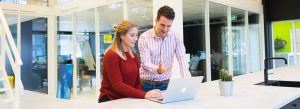How foresight helps predict the future and make rational decisions

A company’s success depends directly on long-term planning. But for a plan to be successful, it must be based on an objective view of the future. Foresight is one of the techniques that help to determine the most realistic picture of the future.
What is foresight
Foresight is a methodology that allows us to formulate images of the future and choose the optimal development strategy based on expert opinions.
The term “foresight” was first used by the English writer Herbert Wells. Back in 1930, he proposed to introduce a new profession – professor of foresight. Such a specialist would have to predict the emergence of new technologies based on the analysis of historical processes and current trends.
Foresight emerged as a full-fledged methodology in the 1950s, at the height of the Cold War and the arms race. It was developed by the American corporation RAND, which carried out strategic planning orders for the US government. Despite the fact that foresight was initially an expensive and labor-intensive technology, it allowed making informed political decisions under conditions of high uncertainty.
Nowadays, foresight is widely used not only in politics, but also in other spheres, such as business, science and education. The main idea of foresight is that the future can be influenced if enough effort is made.
When we talk about foresight, we often mean two different concepts: foresight project and foresight session.
- A foresight project implies a large-scale undertaking divided into many stages. A distinctive feature of a foresight project is the presence of a preliminary research stage. Hundreds and even thousands of specialists may participate in the project. And the period of the project may last for years.
- Foresight sessions are held for a short period of time, with one session lasting only a few days. It usually involves 7 to 15 participants. At present, foresight is most often understood as a foresight session.
How foresight differs from forecasting
Many people mistakenly equate foresight and forecasting, but they are two completely different techniques that have a number of distinctive differences.
- Foresight requires participants to refer to research and perform trend analysis, which is not always done when making forecasts.
- While a forecast is limited to a mere vision of the future, the result of foresight is a clear action plan that takes into account various options for the development of events.
- There are no strict requirements for participants to make a forecast. A forecast can be the opinion of a group of experts or a single person. Foresight always requires the participation of a large number of proactive experts who are directly interested in the result. Among foresight participants there are always stakeholders – people who actively influence the research area and are interested in the implementation of the final decisions.
Areas of application of foresight in business
Foresight is the optimal forecasting methodology for business. Unlike mathematical analysis, futurology and other techniques, it offers an integrated comprehensive approach to form a picture of the future. Conducting foresight is a collective effort, so the methodology does not favor individual methods, and the final conclusions have little dependence on the personal views of the participants.
The methodology has been widely used by large corporations since the second half of the 20th century. Foresight allows companies to develop breakthrough technologies and build new strategies in the market. For example, Shell managed to prepare for the crisis in the energy market of the 1970s and retain its leading position in the industry. Thanks to foresight, Nokia bet on the development of the electronics market and in the 1990s became one of the largest cell phone manufacturers in the world.
Nowadays, foresight is also used to solve narrower tasks. The methodology is used in HR management to identify trends in the labor market and to prepare a recruiting strategy. Holding a session within a company allows management to look at the situation from a different angle, and employees to better understand the company’s goals.
Every year new varieties of foresight appear: strategic planners adapt the methodology to modern trends. For example, foresights are already being organized for startups. Startups organize sessions to make the company more attractive to investors. Having a sound development strategy demonstrates seriousness of intentions and knowledge of the industry.
More recently, another exotic type of foresight has emerged – personal foresight. It is designed to help budding entrepreneurs to fit into the business environment and provide conditions for self-development.
Types of foresight
By holding period:
- Classic or fundamental foresight is conducted with the involvement of a wide range of experts and discussion of the results obtained. Classic foresight can last several years.
- Rapid Foresight provides an opportunity to create an image of the future in a short period of time and bring people together to realize it. Rapid Foresight does not use in-depth foresight methods and the session is only a few days long.
By method of initiation:
- Top-down – the initiative for foresight comes from the top.
- Bottom-up – the initiative comes from below and is based on active interaction between science, business and civil society.
By subject:
- Thematic (sectoral) foresight affects a specific branch of the economy. The purpose of industry foresight is to identify trends in the development of the industry and determine its place in the economic system.
- Territorial foresight is aimed at forming a vision of development of a country, region or district. It is used to identify the unique position of a particular territory, its potential and problems.
- Corporate foresight is conducted to develop a strategy for the development of a particular organization.
- Foresight personalities help aspiring businesspeople adapt to the business environment and identify conditions for self-development.
How to conduct foresight
General rules
Only by following the technology of foresight, it will be possible to obtain an objective assessment of trends, form a picture of the future and a working plan of action. When conducting foresight, it is necessary to adhere to the following rules:
Using multiple methods
Many different methods are used in foresight projects, including PESTEL analysis, expert panels, Delfi method, SWOT analysis, roadmaps, relevance trees, brainstorming and others. Each method is applied at a different stage to solve a specific problem.
Requirements for experts
Special attention is paid to the selection of experts. There are certain requirements to them: the experts should be interested in the research and ready to implement the final decisions.
Just working together
A large number of experts are involved to maximize the objectivity of the results. Forsyth reveals the main advantage of group thinking – the ability to analyze different options and get a complete picture.
Roles of participants
If the foresight is organized not by joint efforts of interested participants, but is carried out to order, the participants are the customer and the executor. The customer can be a company, the government, a public organization, a group of enthusiasts, or a specific person. The executor’s team selects experts and fulfills the roles of the other participants.
Foresight plan
Preforsythe
Preparatory stage, which is conducted by a small number of experts. At this stage, the research area, target audience and the range of experts to be involved are determined.
Foresight program planning
The program includes all formats of research and work, as well as deadlines for implementation. Classic foresights last about 6 days, while modern studies take 1-2 days. At the end, the date of the session is determined and the list of experts is approved.
Definition of the subject area
At this stage, the area of discussion and the scope of future forecasting is determined. Depending on the subject area of the study, experts can be divided into groups.
Identifying trends
This is where the main variants of developments that can have the greatest impact are identified. When identifying trends, experts use the PESTEL method. For the convenience of the workflow, they can be clustered up to 10.
Stakeholder formation
The idea of foresight is that the desired future can be achieved if certain actions are taken. However, in order to realize what is planned, it is necessary to have enough resources, so only stakeholders – participants who can most affect the development of the area under study – can make the projected future scenario a reality. Most often three to six stakeholders are chosen.
Searching for opportunities and threats
It identifies opportunities and threats to stakeholders that may arise during the development of trends. Opportunities are understood as factors of the external environment that can have a positive impact. And threats are potential unfavorable events that can lead to losses and other negative consequences.
To discover opportunities and threats, experts most often resort to SWOT analysis, one of the methods of strategic planning.
Defining the inevitable and desirable future
For each individual stakeholder, an inevitable and a desirable future are formulated. In the first scenario, events unfold negatively and the stakeholder does not try to avoid unfavorable consequences.
The desired future is preferred by the stakeholder. He must accept the possibility of such an outcome and be willing to make efforts to realize it. At the same stage, the gap point – the difference between the inevitable and desired future – is determined.
Developing behaviors to achieve the desired future
Stakeholders need to strive to realize opportunities and minimize threats in order to close the gaps and move closer to the desired future. The penultimate stage involves a role-playing exercise that simulates the actions of stakeholders throughout the planning horizon. The result is a detailed roadmap.
Stakeholders need to seize opportunities and minimize risks in order to close the gaps and achieve the desired future. The penultimate stage involves a role-playing exercise that simulates stakeholder actions throughout the planning horizon. The result is a detailed roadmap.
Reflexion
The last stage of the session. Here the results of the research are summarized, the results of the foresight session, the general organization of work and the methods used are evaluated.
Examples of foresights
Philips conducts regular foresight studies and has even created a separate division, Philips Design. The foresight system at Philips is characterized by high flexibility and dynamism. The company uses a faster approach, which involves developing scenarios of the future for only 5-10 years.
The company has recently shifted its focus from consumer electronics to medical devices. Based on trend analysis, it was concluded that due to the aging of the population and the popularization of healthy lifestyles, the healthcare sector will grow in importance in the long term. At the same time, the traditional consumer electronics market is likely to face stagnation. These conclusions served as a basis for changing the company’s strategic priorities.
How accurate are the predictions
The accuracy of predictions depends directly on the selection of participants, the methods used, the observance of the research technology and the follow-up actions of stakeholders. If all conditions are met, the probability of achieving the desired future is quite high.
As part of foresight, participants work out various options for the development of events. It also takes into account the occurrence of unlikely but significant events that can dramatically change the state of affairs. There is a separate term for such events – “Black Swan”. Such events are necessarily recorded on the map of the future and are taken into account when developing strategies and making plans.
However, it is impossible to predict the future accurately; there is always a risk of force majeure. For example, foresight would not have been able to predict a coronavirus epidemic: there were simply no such precedents in the last 100 years, and there was no data to predict “black swans”.
Conclusions
Foresight differs from other methodologies in terms of thoroughness of research, final result and composition of participants. High accuracy makes foresight an optimal forecasting methodology for business. And thanks to the development of modern technologies, foresight has become a more accessible tool than ever before. Nowadays, companies hold sessions not only to achieve global countries.


